If you are already dealing with facial acne, chances are that other areas of your body are also prone to this inflammatory condition.
Today we’re talking about back acne (bacne), but what is back acne, and why does it happen?
Bacne is an extremely common condition, and to get rid of it, much like regular facial acne, you need to keep the area clean and use active ingredients that can eliminate the overgrowth of bacteria.
Besides treating the area topically, you also need to consider eliminating potential triggers that are causing your back acne.
In this article, I will share seven easy ways to get rid of back acne (bacne) as well as recommend five of my favorite products for bacne.
7 Ways To Get Rid Of Back Acne (Bacne)
- Cleanse with an active cleanser
- Exfoliate
- Condition your hair upside down
- Avoid using heavy moisturizers
- Avoid using fabric softeners
- Check your hormones
- Ask your dermatologist for Isotretinoin
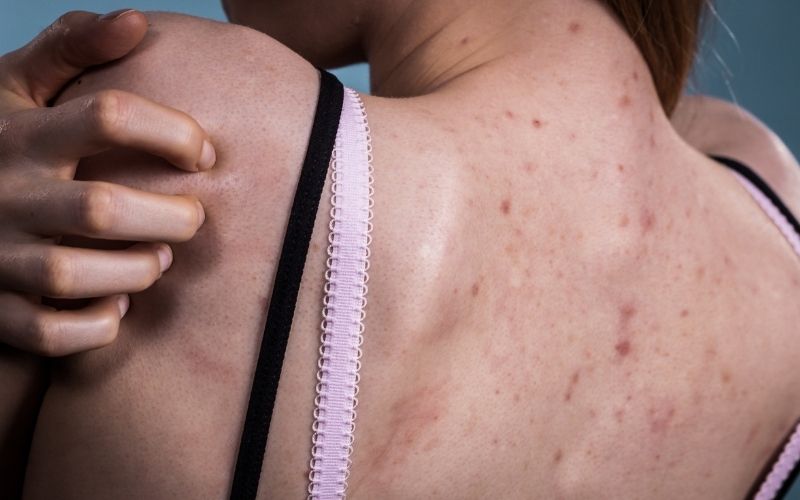
Cleanse with an active cleanser
By this, I mean using a cleanser that contains active ingredients such as benzoyl peroxide.
Benzoyl peroxide is a powerful antibacterial agent that destroys the overgrowth of the acne-causing bacteria by infusing the clogged pores with oxygen.
Products that contain benzoyl peroxide often come in different strengths that you can choose from depending on the severity of your acne.
For stubborn and severe back acne, I would recommend that you choose a cleanser that contains 5 or 10% benzoyl peroxide as these are more effective for penetrating into the thicker skin on the body.
Below, you will find my recommendations for benzoyl peroxide cleansers.
Exfoliate
If your bacne falls in the mild-to-moderate category, regular exfoliation only may help resolve the issue without the need of introducing stronger antibacterial agents.
Gentle exfoliating acids such as mandelic and salicylic acid can unclog the pores by dissolving the gunk inside them, and they can also soothe inflammation.
You can use these exfoliating acids in the form of cleansers and wash the affected area, or you can also use them in leave-on products such as exfoliating solutions and lightweight creams.
On the other hand, avoid any physical exfoliation such as loofah, brushes, or abrasive scrubs, as these are not helpful.
Anything abrasive can rupture the bump and cause pus and bacteria to spread and affect the surrounding area.
Condition your hair upside down
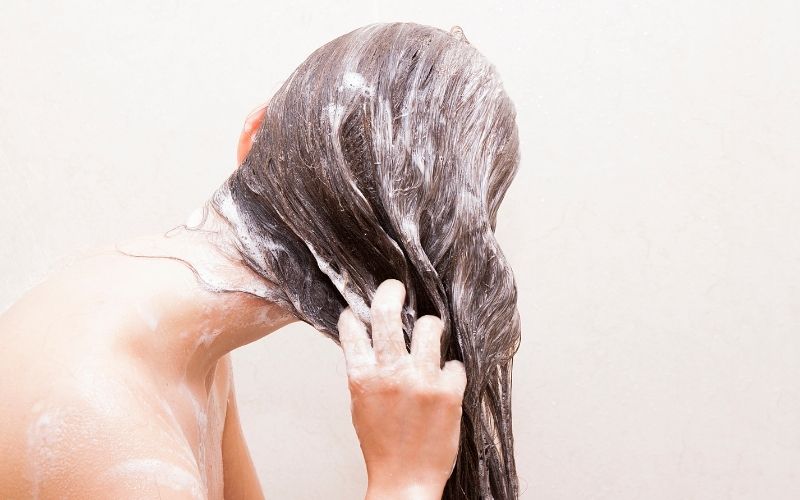
Hair conditioners are often the silent trigger that can cause bacne.
Perhaps hair conditioners are not the only thing causing this annoying condition, but they may very well contribute to it, and you wouldn’t even know because nobody ever mentions it.
I never paid attention to hair conditioners as the culprit for my back acne until I heard my mother complaining that a hair conditioner caused my little sister’s back to break out.
My sister was only 7 at the time, so she wasn’t dealing with puberty hormones, and the hair conditioner was the only out of the ordinary thing my mom used on her.
This is when I looked into the ingredients and realized the ones my mother was using is filled with silicones. So was the one I was using!
Mind you, silicones are not always the issue; however, they can trigger acne for skins that are prone to clogging.
This is how I came to the idea to start conditioning and rinsing my hair while it’s flipped upside down.
By conditioning and then rinsing your hair upside down, you are not exposing your back to potentially clogging ingredients to latch onto your skin and clog your pores, causing more breakouts.
It’s worth mentioning that this method probably won’t get rid of severe acne issues because there’s usually more to it. Still, it is worth trying because it will help you eliminate one potential trigger that could be contributing to the overall issue.
Avoid using heavy moisturizers
Heavy creams, body oils, and moisturizers can also contribute to clogging and more inflammation, essentially making body acne worse.
I would suggest you stop using them all over your body because I find them to be the main cause of back acne and pustular and painful pimples on my legs and lower back, especially during the summertime when I also sweat a lot.
It’s best to give your skin a rest from clogging ingredients and see whether the inflammation improves after several weeks.
Doing this alone will give you the best answer on what could’ve potentially caused or worsened the inflammation.
Avoid using fabric softeners
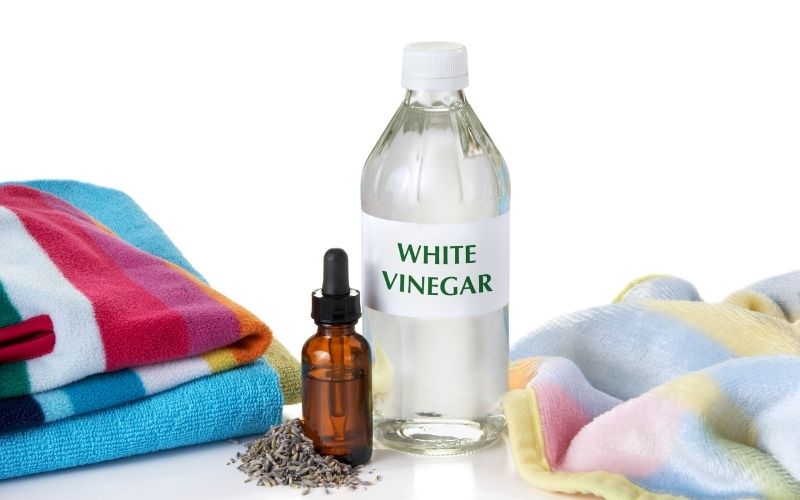
Fabric softeners contain waxy particles that remain on your clothes after washing, and these can irritate the skin and can potentially exacerbate body acne.
It’s also worth mentioning that fabric softeners may not be the only reason for bacne; however, it’s worth avoiding them for some time as an experiment to help you determine whether your acne improves.
Meanwhile, I like to wash my clothes and sheets with vinegar and a few essential oil drops of my choice. I like to use peppermint or lemongrass because these smell very fresh.
I assure you, you won’t smell the vinegar on your clothes or sheets, but the downside of this practice is that the laundry comes out a little coarse after washing because of not using a softener.
If this is something you would like to try out and see whether it improves the issue for you, I encourage you to do so.
Check your hormones
Hormones can stimulate sebaceous activity, which means they can influence how much oil the sebaceous glands produce.
A hormone known to cause acne due to stimulating sebaceous overactivity is the hormone dihydrotestosterone, which belongs to the male group of hormones known as androgens.
These are present in both men and women; however, when the levels are out of whack (usually something caused by eating a bad diet, a prolonged period of stress, bad digestion, etc.), they start to cause issues in the system that will eventually show on the skin.
If you suspect your acne may be caused by imbalanced hormonal activity, it is always a good idea to do a blood test and consult with a doctor to receive adequate treatment.
Use Isotretinoin
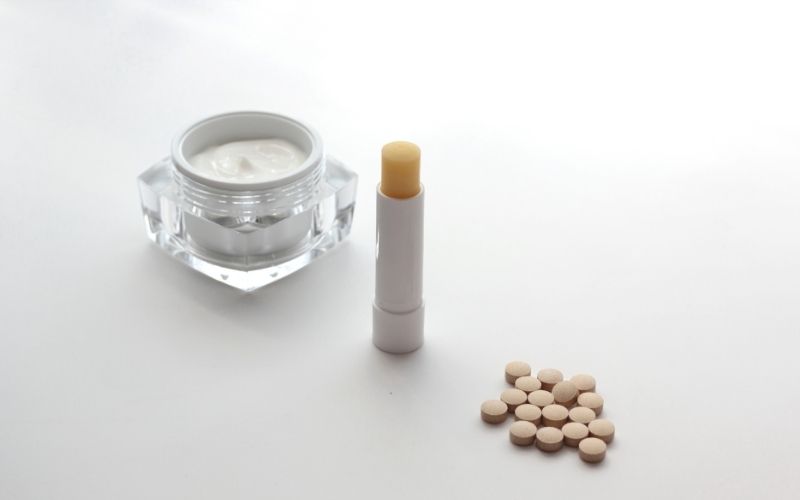
Isotretinoin is a medication that works by drying out the sebaceous glands and reducing sebum production up to 80%.
Many generic names on the market are used to treat severe cystic or nodular acne that has not responded to previous topical treatments, such as benzoyl peroxide or clindamycin (which is usually recommended for Malassezia Folliculitis).
Isotretinoin is also often prescribed to patients dealing with severe back acne as these are known to be stubborn and resistant to over-the-counter treatments.
Although it sounds scary, isotretinoin is not all that bad, and many people have said it has completely changed their lives for the better.
Like any medication, isotretinoin comes with its own set of side effects. These usually stem from the fact that there will be a lack of lubricating sebum in the body while you’re taking the medication.
Lack of lubrication can cause nose bleeds, joint pain, skin dryness and cracking, dry and chapped lips, etc.; therefore, you need to take your moisturizing game up a notch to help you deal with the side effects better.
I’ve never taken isotretinoin myself; however, I wish I had when my back acne was at its most severe while I was in puberty.
This medication can really help, and it’s important to consider it before leaving acne to get too far and leave permanent scarring on the skin.
The 5 Best Esthetician-Approved Products For Bacne
Below, you will find a list of the five products I love and recommend for bacne:
PanOxyl – Benzoyl Peroxide Wash – $17
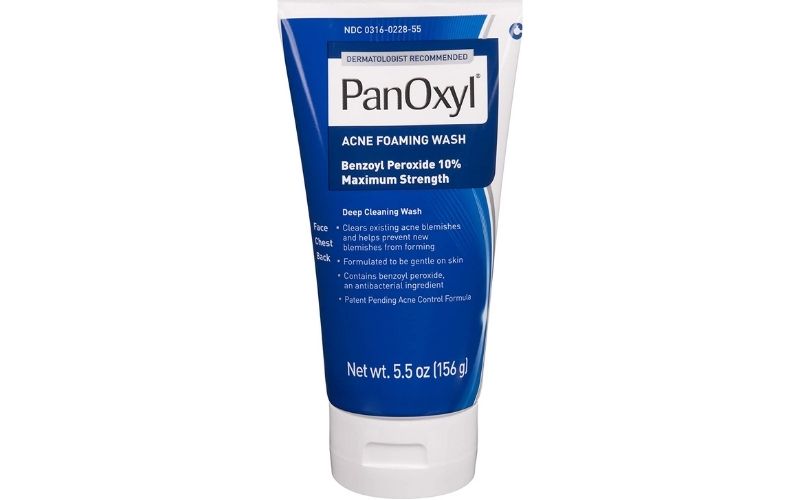
The PanOxyl Benzoyl Peroxide Wash is a super-strong cleanser intended for acne-prone skin. It contains a whopping 10% benzoyl peroxide, an efficient antibacterial ingredient that improves moderate to severe acne.
I would not use this on the face in any circumstance because the percentage is too high.
Benzoyl peroxide has been proven efficient in as low as 2.5% concentration, which is preferable because it minimizes the risk of irritation while still getting the job done.
However, the skin on the buttocks is thicker and can certainly take a higher percentage in a wash-off form, but you should still use it no more than 2-3 times a week.
RELATED: How to use benzoyl peroxide for best results?
Humane – Acne Wash With Benzoyl Peroxide 10% – $22
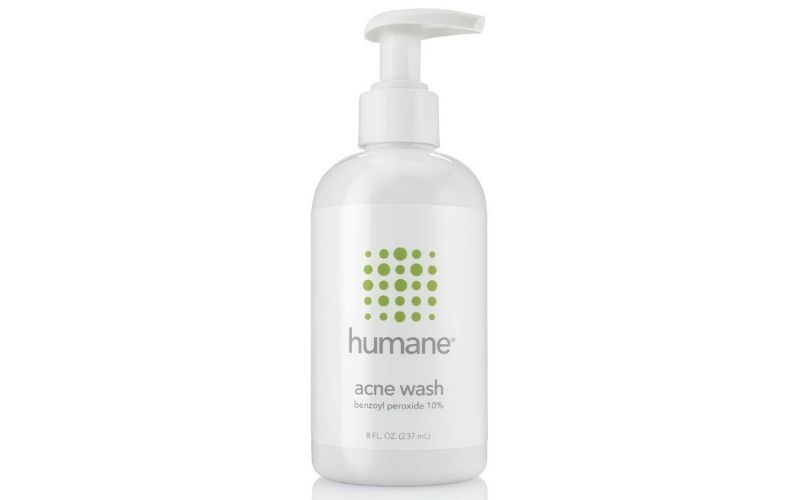
This is another great acne wash containing 10% benzoyl peroxide as an antibacterial agent to infuse the pores with oxygen and eliminate the overgrowth of bacteria.
Humane Acne Wash is a super-strong cleanser that has a concise and straight-to-the-point ingredient list besides benzoyl peroxide.
It can be used on the face and body; however, I would not recommend this for daily use on the face due to its strength. However, since the skin on the back is much thicker, this would be great for daily use.
CeraVe – Acne Foaming Cream Cleanser 4% Benzoyl Peroxide – $15
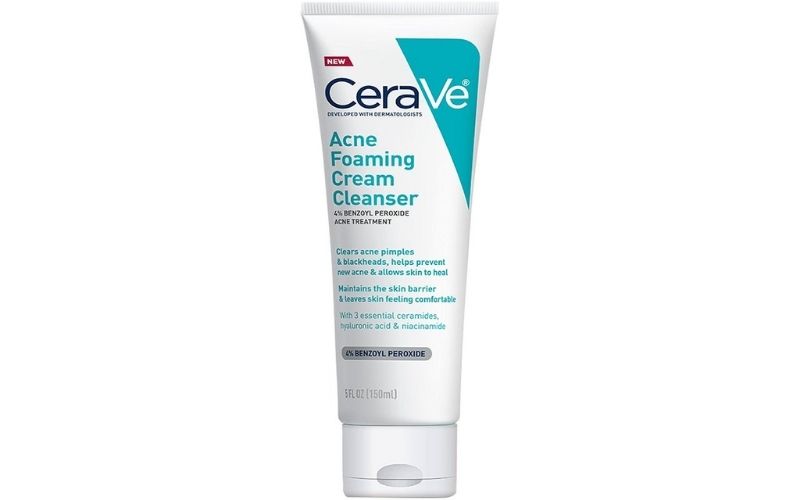
The CeraVe Acne Foaming Cream Cleanser 4% Benzoyl Peroxide is a gentle cream cleanser that contains a good concentration of benzoyl peroxide to help moderate and even severe acne anywhere on the face and body.
This is milder than the ones I already mentioned before; however, benzoyl peroxide is incredibly efficient even at a concentration of 2.5%.
Since this cleanser contains a lower BP concentration, it can also be used on the face; however, avoid using it daily as this may become too drying for the skin.
Paula’s Choice – Acne Body Spray – $25

Paula’s Choice Acne Body Spray is a decent body treatment that contains salicylic acid and other antioxidants that will nourish the skin and help soothe the redness around the affected area.
It also comes in a convenient spray bottle, and it can be used on any body part where you have inflammatory and even cystic acne.
Avoid spraying this product directly onto your face because you may inhale its contents.
Murad – Clarifying Body Spray – $44
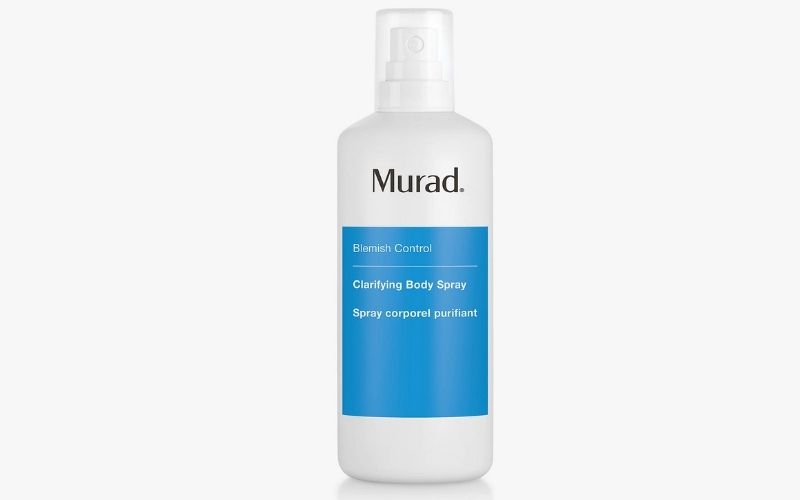
Murad Clarifying Body Spray also contains salicylic acid in the formula that helps penetrate deeper into the pores and eliminate the gunk causing the breakouts on the skin’s surface.
The effective solution is housed in a 360-degree bottle so that you can treat any area on the body with ease.
Back Acne FAQs:
Below, I will answer a few of google’s most frequently asked questions regarding back acne:
What Causes Back Acne In Males?
Severe back acne can result from hormonal imbalances and overactive sebaceous glands in both males and females.
This is often blamed on the male hormones androgen and testosterone, which directly stimulate the sebaceous glands and cause them to produce more oil, which then clogs the pores.
Should I Pop My Back Acne?
It would be best if you never popped acne in any area of your face and body because this can be extremely painful and dangerous.
The infected pus that comes out once you pop a pimple is essentially a mixture of dead skin cells, white blood cells, sebum, and bacteria.
These particles can enter back inside the pores and continue to cause clogs and infections in other areas.
Besides that, popping severe cystic pimples that go deeper into the skin can rupture the blood vessels, which can take much longer to heal than the pimple itself.
What Soap Is Good For Back Acne?
Dove soap or any conventional soap is not a good option for back acne because soaps are very alkaline, which means they are very drying to the skin.
Still, besides being drying, they don’t contain any active ingredients to help fight inflammation and unclog the pores.
For example, benzoyl peroxide can also be drying to the skin, but it is efficient in eliminating the overgrowth of bacteria.
On the other hand, soaps are just drying to the skin with no particular benefit for acne. Instead of wasting your time finding the best soap for back acne, you should invest in a cleanser that contains active ingredients.

My name is Simone and I am a certified skin specialist. I created this website to teach my readers how to take great care of their skin and I also like to occasionally share my honest opinions on skincare products I’ve tried. You can learn more about me here.
